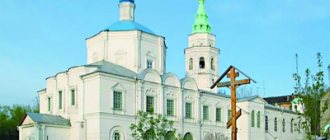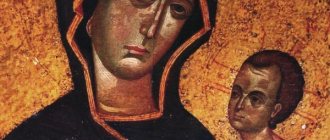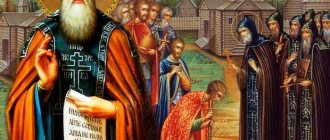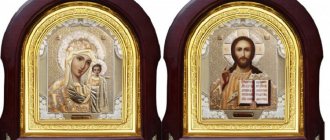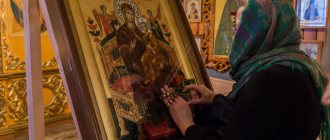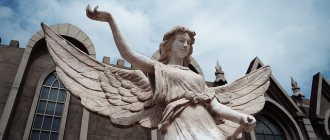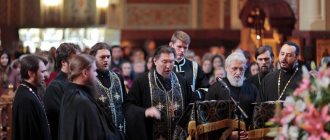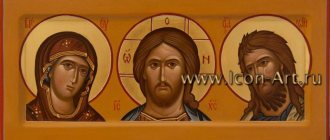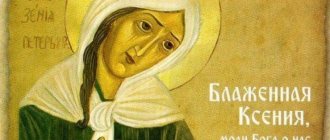"Save me, God!".
Thank you for visiting our website, before you start studying the information, please subscribe to our Orthodox community on Instagram, Lord, Save and Preserve † - https://www.instagram.com/spasi.gospodi/. The community has more than 60,000 subscribers. There are many of us like-minded people and we are growing quickly, we post prayers, sayings of saints, prayer requests, and timely post useful information about holidays and Orthodox events... Subscribe. Guardian Angel to you!
As you know, in the Orthodox faith there is a fairly large number of holy icons, in front of which believers pray for help and healing from many diseases, etc. One of the popular icons in the Orthodox faith is the Pryazhevskaya Icon of the Mother of God. In this article we will look at what this icon is and how it helps.
History of the icon
The miraculous icon of the Mother of God of Pryazhevskaya is one of the most revered shrines of the Kursk land. After 1788, the Transfiguration Cathedral was converted into a church. Various miracles took place in the monastery at that time. More than once there were such cases when in the evening after the service in the monastery all the candles were extinguished, and when believers entered the church in the morning they found burning candles. This phenomenon was repeated until the Pryazhevskaya Icon of the Mother of God was found.
The icon was taken out and outlined by the painter I. Bely. A sign about the restoration of the icon was sent to him from above. The icon was found in 1862. At that time, Ivan was very sick. But after he found it and restored it, a miracle happened. His illness has subsided. Since then, various miracles began to happen.
Probably, it was God’s will and the Mother of God’s will that the ancient monastery begin to host prayer services again. Prayer services resumed after the healing of the merchant Kupreev. In a dream, a messenger of the Lord appeared to him and ordered him to go to the Belgorod closed monastery and hold a service there. When the merchant woke up in the morning, he didn’t think long, but immediately decided to do as he was told in the dream.
The best article for you, go to: St. Meletius of Kharkov
After the healing of the merchant and his sons took place, people began to work to have the church opened. Ivan Kosma and his sons were among the first monks who settled in the monastery after the opening. Since the monastery was opened, the popularity of the icon has increased. People from all over the world began to come to bow and pray before her.
After the Bolsheviks closed the monastery, the icon of the Mother of God survived the attacks of bandits. She was taken to the city of Sudzha. But in the 90s, when an inventory was carried out in the Holy Trinity Church of this city, on the icon with the inscription “Smolensk” it was noticed that the faces and the vestment did not match, which covered the image. After contacting the archive, it was determined that this was the Pryazhevskaya icon. Since 1996, the tradition of crusades with the icon has also been renewed.
Iconography and appearance
According to its iconography, the Pryazhevskaya Icon of the Mother of God belongs to the “Hodegetria” type. It depicts the Virgin Mary with the baby Jesus sitting on her left hand. The image has several colorful layers of different times. The more skillfully executed faces date back to the 17th century, and the rest of the image was updated at the end of the next century. The relic is covered with a silver chasuble, which is decorated with numerous jewelry. Parishioners and pilgrims offer them in gratitude for deliverance from illnesses.
Icon of the Pryazhevskaya Mother of God who helps
As is known in the Orthodox faith, there are many different miraculous icons that help to heal from many diseases and ailments . They also pray before the faces of the saints with requests. The icon of the Pryazhevskaya Mother of God is no exception.
The best article for you, go to: Icon of Theodore Trikhina
It should be noted that contemporaries have found a fairly large number of records that describe the miraculous powers of the icon. As it became known from the recordings, people who prayed in front of the icon received healing:
- For leg disease
- From lung diseases,
- For diseases of the spine.
There were also frequent cases when a woman was healed of infertility and accepted the joy of motherhood.
The miraculous icon of the Mother of God in the temple is decorated with jewelry. In the light of lit candles, it takes on an incredibly beautiful glow. They decorate it for a reason. The believers themselves bring jewelry as a sign of gratitude to the icon for its help.
It must also be said that there is a prayer to the Pryazhevskaya icon. But when you come to the temple to bow before her, you don’t have to read a special prayer. It is enough to sincerely, with all your heart, simply ask the Saint for healing or help in business.
The text of the prayer to the Pryazhevskaya Icon of the Mother of God is as follows:
Oh, Most Holy Lady Theotokos, Queen of Heaven and earth, the highest angel and archangel and the most honest, pure Virgin Mary of all creation, good Helper to the world, and affirmation for all people, and deliverance for all needs!
Look now, O All-Merciful Lady, upon Thy servants, praying to Thee with a tender soul and a contrite heart, falling with tears to Thee and worshiping Thy most pure and wholesome image, and asking for Thy help and intercession. Oh, All-Merciful and Most Merciful Pure Virgin Mary!
Look, O Lady, at Thy people: for we are sinners and imams of no other help than to You and from You, Christ our God born. You are our intercessor and representative. You are protection for the offended, joy for the sorrowing, refuge for the orphans, keeper for widows, glory for virgins, joy for those who cry, visitation for the sick, healing for the weak, salvation for sinners.
For this reason, O Mother of God, we resort to You, and looking at Your Most Pure Image with the Eternal Child held in Your hand, our Lord Jesus Christ, we bring tender singing to You and cry out: have mercy on us, Mother of God, and fulfill our request, for all that is Thy intercession is possible: for unto Thee is glory due now and ever, and unto ages of ages. Amen. Rejoice, God-delighted and Immaculate Ever-Virgin; Rejoice, imperishable and incorruptible Lamb and Shepherd Mother.
May the Lord protect you!
The best article for you, go to: Saints Cyril and Mary of Radonezh
Watch also the video about the miraculous icon of the Mother of God of Pryazhevskaya:
Other Kursk news for this day
7 October 2022, 21:31
Kursk Details of the minibus accident have become known: two passengers were killed, six more people were injured
[/td]
7 October 2022, 22:45In Kursk, investigators are looking into the causes of an accident with a minibus in which women died, the driver is in intensive care | |
7 October 2022, 20:26In Kursk, a minibus had a terrible accident, two passengers died | 7 October 2022, 19:30Kursk region. The FSB closed down an underground online casino in Zheleznogorsk |
7 October 2022, 18:00More than 30 Kursk enterprises will take part in the Golden Autumn exhibition | 7 October 2022, 16:23Povetkin's team is negotiating a fight with Tyson Fury |
7 October 2022, 16:11The Kursk mayor's office told us where to call if they didn't provide heating | October 7, 2022, 16:00Voting “People's Precinct Police Officer - 2019” has started in the Kursk region |
7 October 2022, 15:00In the Kursk region, weather forecasters promise rapid warming | 7 October 2022, 14:30Kursk region. In Zheleznogorsk, a car hit a woman at a crossing |
7 October 2022, 13:45The heating season has begun in all districts of the Kursk region | 7 October 2022, 13:35Kursk took 78th place in the ranking of real salaries |
7 October 2022, 13:32The driver of the Hyundai who drove into the building of a military unit in Kursk does not have a license | 7 October 2022, 13:13A suspect in a series of thefts from citizens' bank accounts was arrested in Kursk |
7 October 2022, 13:00A residential building burned down in the Kursk region | 7 October 2022, 12:47Kursk Three women and an 8-month-old baby were injured in the accident. |
7 October 2022, 12:16A wanted man was detained in Kursk | October 7, 2022, 12:00A 12-year-old and a 65-year-old motorcyclist without a license collided near Kursk |
7 October 2022, 11:48The region's chief police officer thanked the women of Kursk who did not abandon their lost child | 7 October 2022, 11:04In Kursk, Boevka, Borodino Park and Lenin Street will be improved |
7 October 2022, 10:48The elk that crashed a car in Kursk went into the forest | 7 October 2022, 10:24Kursk The guy who was burned in the car worked as a taxi driver |
7 October 2022, 10:15Quadra commented on the emergency on Lenin Street in Kursk | 7 October 2022, 09:55They started turning on the heating in Kursk |
7 October 2022, 09:46Boiling water is pouring on Lenin Street in Kursk | 7 October 2022, 09:39The head of the Investigative Directorate for the Kursk Region will hold a reception of citizens in Sudzha |
7 October 2022, 09:31Kursk The sentence for the killer of a 7-year-old boy came into force | 7 October 2022, 08:22In Kursk, a student was expelled for beating a fellow student |
| 7 October 2022, 07:51 |
There are at least 8 possible authors of the Akathist to the Blessed Virgin Mary
There are several candidates who may turn out to be the authors of the great akathist. From ancient manuscripts it is known that under the walls of Constantinople they sang “To the Mounted Voivode...” This is a hymn to the Mother of God, thanking her for saving this Christian center from enemy troops. But this was not the same akathist yet.
In 626, almost the text that is used today appeared. He expressed gratitude to the Mother of God on behalf of Constantinople. Over time, this version was edited. For example, “Your city” was replaced with “Your servants,” and the text “To the chosen Voivode, victorious...” was used as the opening.
626
this year the text of the akathist appeared, which is still used today
History does not know who authored the final version, but there are versions:
- Reverend Roman the Sweet Singer is a saint. He dreamed of singing in church, but did not have a suitable voice. Everything changed when the Mother of God dreamed of him and gave him a scroll to eat. Roman Sladkopevets became the best singer in Constantinople. He is the author of many Christian hymns, so his authorship is quite likely;
Roman Sladkopevets is the most likely author of the akathist to the Blessed Virgin Mary
- George of Pisidia is a bishop who ascetically defended Christian traditions during the period of iconoclasm;
- Patriarch Sergius I of Constantinople is an influential historical figure. Even the Byzantine emperor Iracius I listened to the opinion. Sergius I was a multifaceted personality and one of the people who ruled the empire;
- Apollinaris of Laodicea was a bishop and theologian who was strongly influenced by ancient culture. The author of a teaching that goes against the traditions of the church;
- Deacon George Pisida is known primarily as a poet. He wrote mainly on historical topics;
- Patriarch Germanus I of Constantinople - revered as a saint, author of several theological works;
- Nun Cassia of Constantinople - poetess, hymn writer, composer, founder of the monastery in Constantinople;
- Patriarch Photius is the author of many works on theology, the initiator of the first attempts to baptize Russia.
There is also an opinion that the akathist is of Syrian origin.
The akathist to the Most Holy Theotokos is great, because through it one addresses Jesus
The Akathist of the Most Holy Theotokos is the very first religious work in this form. Everything that is written after is an imitation of him. That is why a specific date is set aside for the reading of this akathist in the church charter. And all other akathists to the Mother of God or one of the saints are not required in the services.
This akathist is very important for Christianity. The Veneration of the Most Holy Theotokos itself is of considerable importance here. It stems from the idea of the Annunciation. That is, that the word became flesh.
“And the Word became flesh and dwelt among us, full of grace and truth; and we have seen His glory, glory as of the only begotten of the Father.”
(John 1:14)
The Mother of God demonstrates an example of humility by agreeing with God's plan:
“Behold, the Servant of the Lord; let it be done to me according to your word.”
(Luke 1:38)
The Annunciation is one of the central images in the akathist to the Blessed Virgin Mary
This may seem like a small thing. But there is a very deep thought here. All praise for the Mother of God is really centered on Christ. The Akathist gracefully plays out the joy of the church at the condescension of Jesus Christ through the veneration of the Mother of God.
The roots of the Akathists are in Ancient Greece
The very concept of “akathist” refers us to ancient Greek culture. Antiquity is the creativity of its descendants, from sculpture to philosophy. Poetry was no exception. It became so firmly ingrained in people’s consciousness, thanks to ancient Greek authors, that it was even reflected in prayers.
People of the times of Socrates and Plato composed hymns to the gods. The Greek pantheon remains history. But the tradition of praising higher powers has been preserved, including in Christianity. Akathist is a form of praising the saints, Christ or the Virgin Mary.
Akathist
translated from Greek - a song during which one does not sit down
If you translate “akathist” from Greek, you get something like “a song during which one does not sit down.” That is, a sign of respect for higher powers.
From the history of the Pryazhevskaya icon
It is not known exactly who wrote it and when, although at first glance it is clear that this is an ancient Byzantine letter. The icon appeared at the end of the 17th or beginning of the 18th century in the village of Pryazhev not far from Zhitomir, and it got its name from the name of the village. Her appearance was recorded in rural church books.
As was customary, they began to make copies of the Pryazhevskaya icon, and one of them was made in a truly miraculous way. It happened like this. When the Tatars destroyed the Divnogorsk monastery in the Voronezh province, its hieromonks moved to Kursk and founded the Belogorsk Nikolaev Hermitage in 1672. However, in 1788, due to certain circumstances, the hermitage was closed, and the Transfiguration Cathedral that belonged to it became the parish church of the nearby settlement of Gornali.
Tradition says that it was then that miracles began to happen in the church, which was once a monastery: at the end of the service, all the candles were certainly extinguished to avoid a fire, but the next morning it was discovered that some of them were burning again. This happened before the Pryazhevskaya Icon of the Mother of God was rediscovered.
According to Abbot Nestor, who wrote down this amazing story in 1862, the artist Ivan Bely, who led a pious life, received a revelation from above that behind the iconostasis of the church, which once belonged to the monastery and still survived until that time, there was an ancient icon of the Virgin Mary, painted on canvas. Ivan was ordered to take out the icon and carry out its renovation, without affecting the faces of the Mother of God and the Child, for they were preserved intact.
Until that moment, no one knew either about the very existence of such an icon, or about where it was hidden, but Ivan Bely, accompanied by a priest and a sexton, discovered the icon exactly where it was indicated in the revelation. The painter suffered from illness, but after a prayer service was served in honor of the appearance of the icon, he completely recovered.
And then the Pryazhevskaya icon of the Mother of God did not cease to show miracles. There lived in the city of Sudzha, Kursk province, a merchant Kosma Kupreev, a pious and God-fearing man, who fell ill with a serious illness. He also received a revelation in a dream - to go to the Belogorsk Monastery, which by that time was already closed, and serve a prayer service in front of the miraculous icon.
The merchant did so and completely got rid of his illnesses, and after that, supported by his two sons, he began to strive for the restoration of the monastery. Finally, on August 24, 1863, the highest order came to restore the monastery, which was now to be called the Belogorsk Nikolaev Hermitage. Among its first monks were Kosma Kupreev and his sons.
When the monastery was restored, the miraculous Pryazhevskaya icon of the Mother of God was
The Akathist of the Most Holy Theotokos is read on Akathist Saturday
The church charter regulates when this akathist is read. This happens on Saturday morning of the fifth week of Great Lent, in the Lenten Triodion. The same already mentioned feast of the Praise of the Blessed Virgin Mary. This is a sign demonstrating the exceptional position of this text.
Vologda Church of the Apostle Andrew the First-Called on Akathist Saturday - the day when the Akathist of the Blessed Virgin Mary is read
Why exactly this day? Here is what Priest Mikhail Asmus says about this:
“The miracle itself happened on this day - Saturday of the fifth week of Great Lent.
But since the Church also lives according to the Easter calendar, the holiday on the day associated with Easter will be transferable.”
Mikhail Asmus
priest
Also, Priest Mikhail Asmus explains why such love for this holiday in Orthodoxy is connected:
“Everyone loves akathists to the Mother of God. Especially the Russians, who have many imitations.
In the church consciousness, the theme of the miraculous intervention of the Mother of God in the military affairs of the state was fixed on this day.
And what in history and in worship was attributed to Constantinople, every Orthodox city tries to attribute to itself.
Mikhail Asmus
priest
Of course, you can read this akathist at home, but public worship expresses the conciliarity of the Church. And such a public reading of the Great Akathist reminds us of Orthodox statehood, because such miracles were possible only thanks to Orthodoxy as the state religion.
The Great Akathist consists of Kontakia interspersed with Ikos.
The ikos, in contrast to the kontakion, contains the text of joyful glorification (“Rejoice, by which joy will shine: Rejoice, by which the oath will disappear...”, etc.) and a special, repeated at the end of each ikos, the same ending-refrain (“Rejoice, unbridled Bride ").
Kontakion and ikos form, as it were, one block of the akathist. There are 12 such blocks in total. All akathists now have this structure.”
Icon of the Blessed Virgin Mary “Pryazhevskaya”
The ancient Pryazhevskaya Icon of the Mother of God is venerated in several southern dioceses of the Russian Orthodox Church. Nowadays, one of its oldest lists, located in the Belogorsk Nikolaev Hermitage, is especially revered.
History of the Holy Face
There is no reliable information about the origin and authorship of the Pryazhevskaya Icon of the Mother of God. Researchers believe that its original was written no later than the 14th century in the Byzantine icon-painting manner. Over the centuries-old history, the image was lost and found again several times.
Pryazhevskaya Icon of the Mother of God
First acquisition
At the turn of the 17th-18th centuries, an image of the Virgin Mary with the baby Jesus in her arms appeared in a small church in the village of Pryazheva. Since then, it has been called after the place where it was first found - the icon of the Pryazhevskaya Mother of God.
Until the beginning of the 18th century, it was brought annually to the cathedral of the city of Zhitomir, which is located 6 km from the place of the first apparition. Until the end of the century, the church in Pryazhevo was in the hands of supporters of the union between the Orthodox and Catholic churches.
Historians believe that it was at this time that information about the acquisition of the revered image was lost.
In the second half of the 19th century, the miraculous image acquired a silver chasuble donated by Empress Maria Alexandrovna. After 30 years, with the permission of the Holy Synod, the Zhytomyr religious procession was resumed.
During the formative years of Soviet power, the Pryazhevo church and its main shrine were destroyed. But the image of the Pryazhevskaya Mother of God was not lost irretrievably, since several copies of the original have been preserved. Notable among them are the images located in the following holy places:
- in the Church of the Transfiguration of the city of Zhitomir;
- Trigorsk Spaso-Preobrazhenskaya Monastery;
- Gornalsky St. Nicholas Belogorsk Monastery.
On a note! The second discovery of the miraculous image is associated with the Gornal list.
Second discovery: Gornal list
Researchers believe that the Gornalsky copy of the icon of the Pryazheskaya Mother of God was made from the original shortly after its discovery. Initially it was located in the Divnogorsk monastery, located near the city of Ostrogozhsk.
In 1671, after another raid by the Crimean Tatars, several monks left the monastery, taking with them the Pryazhesky image of the Mother of God.
On the high chalk bank of the Psel River near the village of Gornal they founded a new monastery - the Belogorsk Nikolaev Hermitage.
A hundred years after its founding, the monastery was closed, leaving only the Transfiguration Church, which received parish status. It was to this time that the second acquisition of the image of the Pryazheskaya Mother of God dates back. According to legend, at the end of the 18th century miracles began to occur in the parish church. To avoid fire, all candles were extinguished at night, but in the morning, after the opening of the temple, they were found burning.
Miracle-working Icon of the Mother of God “Pryazhevskaya” (Gornalskaya)
The miracle was repeated until the discovery of the miraculous image, which was found after a revelation sent to the artist Ivan Belov.
The painter and the rector of the temple found the shrine in exactly the place indicated in the vision.
The artist, who received healing from a serious illness after finding the icon, updated the colorful layers of the image without affecting the face and brushes of the Virgin Mary and the divine child.
Veneration of the icon in the 19th century
The veneration of the Pryazhevsky image increased in the second half of the 19th century, when the Belogorsk monastery was revived. This event is connected with the miracle of healing of the Sudzhen merchant Kosma Kupreev.
One night, the pious husband had a vision in which he was told that he would receive healing by serving a service before the icon of the Mother of God located in the main church of the closed Belogorsk monastery.
Having completed everything that was said in the knowledge, the merchant received healing.
In gratitude for the miraculous deliverance from the disease, Kosma, together with his sons Fyodor and Vladimir, advocated for the restoration of the monastery. His efforts did not go unnoticed, and in 1863 the holy place returned to life. The former merchant and his sons became one of the first inhabitants of the revived monastery.
At the end of the century, a tradition of religious processions led by the Pryazhevsk Icon of the Mother of God developed.
During the year three transfers of the image took place:
- On the Feast of the Ascension, a procession of the cross was sent from the monastery to the city of Miropolye, where the miraculous image remained until the day of the Most Holy Trinity.
- In the fall, the shrine was delivered to the monastery chapel of Alexander Nevsky located nearby in Sudzha.
- During the period between the holidays of the Dormition of the Blessed Virgin Mary and Christmas, the holy image was carried throughout all settlements of the Sudzhensky district.
Especially for the shrine, a chapel of the same name was added to the Transfiguration Church. In winter, it was moved to the heated Church of the Intercession.
The fate of the icon in the 20th century
The Bolsheviks closed the Belogorsky Monastery in 1922, but the monastic brethren managed to live in chalk caves until 1937.
As a result of increased repression, the monks left Gornal and, taking their main shrine, went to Sudzha. Initially it was placed in the Assumption Cathedral, but then it was moved to the Trinity Church.
The latest information about the fate of the relic dating back to Soviet times dates back to 1946.
For fifty years, the Pryazhevskaya Icon of the Mother of God was considered irretrievably lost. But in 1996, the ministers of the Trinity Church noticed a discrepancy between the face and robe of the image of the Smolensk Mother of God. During the study of archival records, it was found that under the salary there is a miraculous image considered lost.
Procession with the Icon of the Virgin Mary “Pryazhevskaya”
Today the image has returned to the Gornalsky St. Nicholas Belogorsky Monastery. In 1996, the tradition of religious processions was resumed.
Interesting! The traditional religious procession in Miropol'e began to be held again in 2002. But since 2015, due to political events in the neighboring fraternal state, it has been carried out along the border. At the same time, many Ukrainian pilgrims take part in it, praying for peace in their country.
Iconography and appearance
According to its iconography, the Pryazhevskaya Icon of the Mother of God belongs to the “Hodegetria” type. It depicts the Virgin Mary with the baby Jesus sitting on her left hand. The image has several colorful layers of different times.
The more skillfully executed faces date back to the 17th century, and the rest of the image was updated at the end of the next century. The relic is covered with a silver chasuble, which is decorated with numerous jewelry.
Parishioners and pilgrims offer them in gratitude for deliverance from illnesses.
What to pray for
The Day of the Pryazhevskaya Icon of the Mother of God is celebrated twice a year:
- July, 12;
- tenth Friday after Easter.
It is on these days that prayer at the icon has great power. When making a request to the Heavenly Intercessor, you can recite the words of a special prayer or the text of any Mother of God akathist. But even simple sincere words will be heard by the Mother of God.
They ask for help in front of the Pryazhevskaya icon in the following cases:
- for diseases of the lower extremities and back;
- diseases of the respiratory system;
- for infertility;
- in various everyday problems.
Although the icon of the Pryazheskaya Mother of God is considered revered in a certain area, the fame of its miraculous power spread throughout all Orthodox lands. Every year thousands of pilgrims come to Kursk to ask for help and protection from the Heavenly Intercessor.
Icon of the Blessed Virgin Mary “Pryazhevskaya”
Source: //molitva-info.ru/ikony/ikona-bozhiej-materi-pryazhevskaya.html
